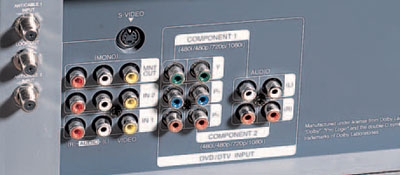Zenith R49W36 49-inch HDTV Monitor Page 2
In addition to a pair of wideband component jacks that accept standard 480i, progressive-scan 480p, or high-def 1080i signals, the back panel includes a typical array of A/V inputs, but only one S-video jack. If you don't use an A/V receiver for S-video switching, you may wish for another such input or two, but the most important omission here is any kind of digital video connection. Many new HDTVs have a copy-protected DVI (Digital Visual Interface) input with HDCP copy protection, which guarantees compatibility with DVI equipped satellite receivers. Although all current high-def satellite - and cable - receivers have an analog component-video output, there's a possibility that on future boxes the connection will be limited to carrying standard-definition signals for certain programs. 
| FAST FACTS |
| KEY FEATURES • Widescreen HDTV with 49-inch screen • Native 1080i high-def display • Converts standard programs to 540p or 1080i format INPUTS/OUTPUTS side inputs composite/S-video with stereo audio rear inputs 2 wideband component video, S-video, and 2 composite video, all with stereo audio; 2 RF antenna outputs composite video with stereo audio DIMENSIONS 53 1/2 inches high, 47 1/2 inches wide, 23 3/4 inches deep WEIGHT 146 pounds PRICE $1,699 MANUFACTURER Zenith, Dept. S&V, 2000 Millbrook Dr., Lincolnshire, IL 60069; www.zenith.com; 877-993-6484 |
The Yankees game afforded a good opportunity to test how the R49W36 filled its wide screen with standard 4:3 images. Happily, the set's normal 4:3 mode places gray letterbox bars to either side of the picture, which helps the tubes wear more evenly (in another step to prevent burn-in, when you select 4:3 an Auto Move feature shifts the picture slightly over time). Some viewers prefer to fill the screen completely, so in addition to the standard 16:9 Wide mode - which simply stretches the picture horizontally, making Derek Jeter look like Don Zimmer - the TV has three modes that stretch the image more subtly. All settings worked with both progressive-scan and HDTV sources except for one called Panorama, which didn't work with 1080i.
After watching the Bronx Bombers destroy another rival, I spun up the DVD of Final Destination 2 in anticipation of more wanton destruction. In this B-grade horror flick, Mr. Death takes revenge on people who somehow escaped his scythe the first time around. The most impressive scene occurs when the nervous teenage heroine, Kimberly, foresees a massive traffic accident that will doom a rainy road full of annoying motorists. When fed the progressive-scan signal from the DVD player, the R49W36 handled the main crash with stunning realism. A gore-smeared log that smashes through the canopy of a cop car looked appropriately disgusting, and shadowy details in the undersides of rolling cars were plainly visible. I could even see strands of blonde hair protruding from the sunroof of an inverted-in-midair Suburban.
When I switched the DVD player to interlaced mode and let the TV handle the processing, however, I began to notice subtle stairstep patterns in the image. At one point, for example, the camera rises from the hood of a Firebird caught in traffic, and I saw moving lines on the edge of the windshield. According to Zenith, the set uses 2:3 pulldown to prevent such "motion artifacts" on film-derived programs, but the circuit is active only in 1080i mode. However, our test sample showed no evidence of 2:3 pulldown in either the 1080i or 540p mode, so I recommend using a good progressive-scan DVD player.
| HIGH POINTS Inexpensive. Easy setup and operation. Dual component-video inputs. LOW POINTS No DVI input. No 2:3 pulldown processing. |
With HDTV sources, namely the 1080i PBS demo loop showing scenes of Baltimore's Camden Yards, the Zenith set looked extremely good, with only a hint of softness in shots of buildings and the stadium. Savoring the exquisite detail during a pan over the skyline, I did notice slight bending toward the edges of the screen - it seemed like the scene was passing over uneven rollers. The effect also appeared with non-high-def sources, but only during extended horizontal pans.
Despite these quibbles, the R49W36 does what it sets out to do: deliver a big-screen HDTV image in an easy-to-use package. And as icing on the cake for HDTV shoppers, this trusty Zenith does it for less money than two weeks worth of classes at MIT.
In the Lab
Color temperature (Warm setting before/after calibration) Low window (20 IRE) NA/5,845 K High window (80 IRE) 6,215/6,500 K
Brightness (Warm setting before/after calibration) 90.4/32.5 ftL
With its Warm setting selected, the R49W36 measured close to the NTSC standard for the upper end of the grayscale, but on the 20- and 30-IRE windows it was beyond the range of our lab equipment - both test patterns looked green. After calibration, the 20-IRE window had a reddish bias, but the rest of the grayscale was within 300 K of the standard. (Calibration needs to be performed by a qualified technician with specialized equipment, so discuss it with your dealer before purchase, or call the Imaging Science Foundation at 561-997-9073.)
After calibration, light output was good for a rear-projection TV. The set's NTSC color decoder accentuated reds, so I reduced the color control to achieve a more accurate palette. DC restoration was below average, with the level of black varying significantly with scene-to-scene changes in picture brightness. Before calibration, overscan patterns indicated a shift of about 10% to the bottom and 8% to the right; after calibration overscan was negligible. Edge enhancement was faintly visible with scan-velocity modulation on, but it was nonexistent with SVM defeated and sharpness reduced to about 10%.













































